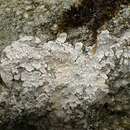pms
nòm ant ël fil


Trapeliaceae is a family of lichens in the order Baeomycetales. The family contains 12 genera and about 125 species.[2]
Trapeliaceae was originally circumscribed by French lichenologist Maurice Choisy in 1929. Hannes Hertel emended the family in 1970.[3] Because of similarities in ascus structure, the family was originally classified in the Agyriineae, a suborder of the Lecanorales. Preliminary molecular phylogenetic studies showed that Agyriineae was not related to the Lecanorales, and the order Agyriales was resurrected to contain the family. Some authorities considered Trapeliaceae to be synonymous with Agyriaceae.[4]
In 2007, Thorsten Lumbsch and colleagues transferred Trapeliaceae to the order Baeomycetales based on a sister relationship between Trapeliaceae and a clade in the Baeomycetales.[5] This placement contradicted the results of some previous phylogenetic analyses that showed the Trapeliaceae as neither sister nor contained within the Baeomycetales.[6][7] In 2011, Brendan Hodkinson and James Lendemer proposed the order Trapeliales to contain the family, as they considered the family to be part of "a clade that is molecularly and morphologically distinct from Baeomycetales".[8] In 2018, the Lecanoromycetes was revised using a temporal approach that uses time-calibrated chronograms to define temporal bands for comparable ranks for orders and families. In this work, Trapeliales was synonymized with Baeomycetales.[9] In a later review of the use of this method for biological classification, Robert Lücking considered this merge justified.[10] This synonymy has been accepted in a recent review of fungal classification.[2]
Trapeliaceae is a family of lichens in the order Baeomycetales. The family contains 12 genera and about 125 species.
Trapeliaceae es una familia de hongos ascomicetos en el orden Baeomycetales. Son hongos liquenizados con talos asociados a algas verdes. De tamaño mediano, actualmente la familia incluye más de 120 especies agrupadas en 14 géneros.
Según Outline of Ascomycota—2009,[1] los siguientes géneros están alojados en esta familia :
Placynthiella oligotropha
ejemplar de herbario
Xylographa parallela
ejemplar de herbario
Trapeliaceae es una familia de hongos ascomicetos en el orden Baeomycetales. Son hongos liquenizados con talos asociados a algas verdes. De tamaño mediano, actualmente la familia incluye más de 120 especies agrupadas en 14 géneros.
Les Trapeliaceae sont une famille de champignons ascomycètes. Il s'agit de lichens au thalle encroûtant associés à des algues vertes. De taille moyenne, la famille comporte actuellement plus de 120 espèces regroupées en 14 genres.
En 1990, sur la base de caractères anatomiques, les lichens jusqu'alors classés dans la famille des Trapeliaceae ont été placés dans les Agyriaceae. En 2007, une étude faisant appel à des caractères moléculaires a montré que cet arrangement ne pouvait rendre compte des parentés véritables et conduit au rétablissement des Trapeliaceae[1].
Selon Outline of Ascomycota—2009[2] :
Placynthiella oligotropha
exemplaire d'herbier
Xylographa parallela
exemplaire d'herbier
Les Trapeliaceae sont une famille de champignons ascomycètes. Il s'agit de lichens au thalle encroûtant associés à des algues vertes. De taille moyenne, la famille comporte actuellement plus de 120 espèces regroupées en 14 genres.